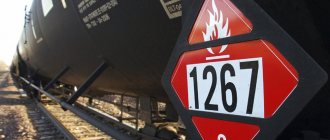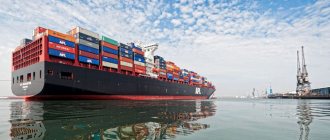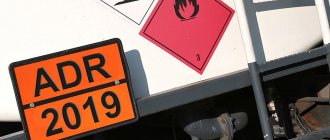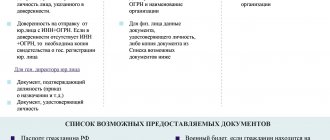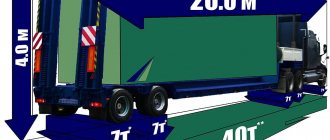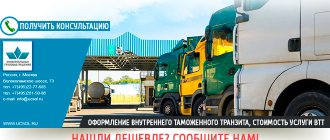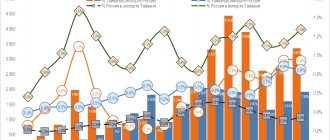Fire, explosion, leakage of radioactive substances - these are the possible damages that can result from improper transportation of dangerous goods. To protect people and the environment, developed countries have developed regulations for the transportation of hazardous substances for all types of transport. In this article we will describe the rules and requirements for the transportation of dangerous goods by land road transport in Russia, consider the main nuances, violations and liability of legal entities for violations.
- What is dangerous goods
- Classes of dangerous goods
- Who has the right to transport dangerous goods?
- Rules for the transportation of dangerous goods by road
- Documents required for the transport of dangerous goods
- Requirements for drivers to transport dangerous goods
- Requirements for vehicles for transportation of dangerous goods
- Permission to drive a vehicle with dangerous cargo
- Violations and fines for incorrect transportation of exhaust gases
- Payment of fines for dangerous goods at a discount
What is dangerous goods?
Substances and products whose chemical properties or technical features cause danger to humans and the environment are classified as dangerous goods. JSC Avtokolonna 1989 transports dangerous goods throughout St. Petersburg, Russia, Europe and Asia.
When transporting goods classified as dangerous, it is necessary to follow the standards of international transportation. Previously, Russia had its own regulatory act, which contained the rules for the road transport of dangerous goods within the country. But starting from 2021, the European Agreement - ADR - is in force on the territory of the Russian Federation, which contains standards for the road transport of dangerous goods. The document covers all issues: cargo classes; rules of loading, transportation, labeling; container requirements; driver actions in emergency situations, etc.
Class 8. Caustic and corrosive substances
Corrosive substances, which include substances and products containing substances of this class, which, due to their chemical properties, affect epithelial tissue - skin or mucous membrane - upon contact with it or which, in the event of leakage or spillage, can cause damage or destruction of other cargo or transport means, and may also create other types of danger. The name of this class also covers other substances which form a corrosive liquid only in the presence of water or which, in the presence of natural air humidity, form corrosive vapors or suspensions.
Additional information about the subclass
Class 8 substances are classified into the following three packing groups depending on the degree of hazard they pose during transport:
- Packing group I - highly corrosive substances.
- Packing group II - corrosive substances.
- Packing group III - slightly corrosive substances.
The symbol (liquids pouring out of two test tubes and hitting the hand or metal) is black. The background is the top half is white, the bottom half is black with a white border. The number "8" is white in the lower corner.
Classes of dangerous goods
POG is carried out in accordance with their class. Each class requires special conditions of transportation. Therefore, there is a classification of hazardous substances. It contains the following classes and their subclasses:
Class 1
– substances capable of exploding and burning. This also includes most types of explosive products or devices used in pyrotechnics: Subclasses:
1.1
. - chemicals and products, the explosion of which instantly engulfs the entire cargo in a blast wave.
1.2
– materials that are incapable of exploding in mass.
1.3.
– compounds that burn without explosion.
1.4.
– chemicals that can explode if ignited during transportation, but this will not damage the packaging or other cargo. The likelihood of their explosion is extremely low.
1.5
– substances that practically cannot explode during transportation, even if ignited.
1.6
- chemical compounds that never explode in mass or this is very unlikely.
Class 2
– hazardous substances in gaseous form, liquefied by cooling and dissolving under pressure. Requirements:
- At a temperature of 50 degrees Celsius, the absolute vapor pressure is 3 kgf/cm2 (300 kPa) or more;
- The critical temperature value does not exceed 50 degrees.
Gases come in the following states:
- Compressed with a critical temperature threshold of less than – 10 degrees;
- Liquefied, for which the critical temperature is -10 or higher, but not less than 70 degrees;
- Liquefied, having a maximum temperature value of 70 degrees or more;
- Aerosols or gases in compressed form requiring compliance with special regulations.
Subclasses:
2.1. – not capable of ignition;
2.2. – poisonous but non-flammable gases;
2.3 – gaseous compounds that ignite extremely easily;
2.4 – gaseous chemicals are poisonous and easily flammable;
2.5 – having a chemically unstable composition;
2.6. – gases with a chemically unstable toxic composition. Class 3
- liquids or mixtures thereof, the ignition of which can easily occur at a temperature of 61 degrees or below.
Subclasses: 3.1
. – liquid chemicals with a flash point of less than -18 degrees, as well as liquid substances with other dangerous properties other than flammability;
3.2
– chemicals in a liquid state, the flash point of which does not exceed 23 degrees;
3.3
– liquid substances that ignite at temperatures up to 61, but above 23 degrees.
Class 4
– dangerous substances, the ignition of which can occur very easily during transportation, but do not explode.
Subclasses: 4.1
– substances that burn in solid form;
4.2
– compounds that independently heat up and burn;
4.3
– chemical compositions capable of releasing flammable gas under the influence of water.
Class 5
is a type of dangerous goods that can oxidize, ignite, or explode under certain conditions.
Subclasses: 5.1
– non-flammable compounds that provoke the combustion of other materials or things;
5.2
– peroxides that ignite when rubbed or interact with anything.
Class 6
- poisonous or infectious substances or objects.
Subclasses: 6.1
– substances that are toxic if inhaled, come into contact with skin or if swallowed;
6.2
– materials containing microorganisms that cause serious illness.
Class 7
– radioactive compounds with a specific radioactivity of 70 kBq/kg (2 nCi/g).
Class 8
– substances with caustic or corrosive properties. They can cause damage to human mucous membranes, corrosion of cargo vehicles in which transportation is carried out, and harm other things.
Subclasses: 8.1
– acids;
8.2
– alkalis;
8.3
– other chemicals that are corrosive or caustic.
Class 9
– dangerous goods that are not classified in other categories, but require safe transportation in compliance with special conditions.
Subclass 9.1
– liquids or solids that may catch fire under certain conditions at extremely high temperatures;
Class 2. Gases
Gases, which include pure gases, mixtures of gases, mixtures of one or more gases with one or more other substances, and products containing such substances. A gas is a substance that: at a temperature of 50°C has a vapor pressure of more than 300 kPa (3 bar) or is completely gaseous at a temperature of 20°C and a normal pressure of 101.3 kPa.
Additional information about the class
The main, main danger: the pressure under which the gas is in the vessel. Class 2 substances and articles may have various additional hazardous properties. Depending on their hazardous properties, they belong to one of the following groups:
- A - suffocating;
- O - oxidizing;
- F - flammable;
- T - toxic;
- TF - toxic, flammable;
- TC - toxic, corrosive;
- TO - toxic, oxidizing;
- TFC - toxic, flammable, corrosive;
- TOC - toxic, oxidizing, corrosive.
Substances and products of class 2 are divided into:
- Compressed gases: gases with a critical temperature below 20°C;
- Liquefied gases: gases with a critical temperature of 20°C or higher;
- Refrigerated liquefied gases: gases that are partially liquid during transport due to their low temperature;
- Gases dissolved under pressure: gases that are dissolved in a solvent during transport;
- Aerosol sprays and small containers containing gas (gas cartridges);
- Other products containing gas under pressure;
- Non-pressurized gases subject to special requirements (gas samples).
Flammable gases Symbol (flame) - black or white. Background is red. Number "2" in the bottom corner.
Non-flammable, non-toxic gases Symbol (gas cylinder) - black or white. Number "2" in the bottom corner.
What is ADR?
ADR or ADR (carriage of dangerous goods by road) regulates the rules for the transportation of all of the above materials and substances. The document was adopted in 1957. Since then, new editions have been published annually. You can familiarize yourself with ADR 2021 on the website of the Ministry of Transport. Link to materials: https://rosavtotransport.ru/ru/activities/dangerous-goods/documents/
How to obtain a transportation permit?
Transportation permits can be obtained from companies accredited by the Ministry of Transport. The vehicle must comply with transportation standards. The driver must undergo ADR training and certification. It is obvious that the high responsibility for the transported dangerous goods (DG) also imposes serious requirements on the vehicle (VV).
Structure of ADR
The document itself is quite voluminous - the first volume alone contains about 700 pages. It is divided into two parts. The first has seven sections, the second two.
The first seven sections are devoted to:
- General provisions
- Classes of substances and materials
- List of OG
- Requirements for containers and containers for transportation
- Transportation stages
- Requirements for container quality
- Requirements for loading/unloading, transportation
The second appendix describes the requirements for the driver and vehicle.
Two voluminous volumes of ADR
Transport requirements: how to equip a vehicle for transporting dangerous goods?
The following requirements are imposed on the equipment of special equipment for transportation of exhaust gases:
- The presence of a protective device that prevents tanks, cylinders or batteries from accidentally falling out.
- The fuel tank is insulated with metal gaskets
- The battery is located in a ventilated compartment. The terminals are insulated.
- The presence of special markings and a flashing lamp to attract the attention of other road users.
- The muffler is located at the front of the car
- All electrical wiring is laid in insulating material
- Availability of on-board battery power switch
- The vehicle is equipped with GLONASS or GPS satellite navigation
In order to ensure transportation safety, it is prohibited to tow more than one vehicle with exhaust gas and transport more than one semi-trailer with dangerous goods.
Permission form for POG:
Labeling - font and image standards
The Dangerous Goods carrier must apply special markings to the vehicle to indicate the type of dangerous cargo. The sign is a diamond, in the upper part of which the class of the substance or material is indicated, in the lower part there is a UN class number.
All inscriptions on the vehicle are at least 15 cm in height. The most important condition for marking is its durability and resistance to fire and other external factors. This is necessary so that in the event of an emergency, rescuers arriving at the scene can immediately navigate the neutralization of the fire. After all, extinguishing a fire with water in the event of a leak of a number of dangerous chemicals will have a detrimental effect on the situation.
Samples of marking signs for each exhaust class
Marking
The organization of transportation of dangerous goods is carried out in accordance with their labeling. Therefore, each such item or substance must be marked in the prescribed manner and according to certain rules. Based on them, the carrier carries out transportation without deviating from these requirements.
The category of hazardous chemicals must be marked on each container or package. Remains of transported items and trains, transport, packaging materials that have not been cleared of hazardous waste in the prescribed manner should also be marked. It is allowed not to mark packages for transportation if the main mark on the cargo can be seen on the side or end.
Depending on the type of transported substances or products, the marking contains:
The package or packaging bears a danger sign, UN number, name of the cargo to be transported, as well as a class code;
Larger packaging and containers should be marked with the hazard symbol, UN number. If transportation is carried out by rail, then it is also necessary to indicate the emergency card number. If it is not numbered, then the card is located along with the documentation.
Special markings indicating the degree of danger of the transported substances must be on:
- Any packaging next to the designations about permissible manipulations in accordance with GOST 14192. The designation is contrasting and noticeable;
- On the container - on the side, door and lid, if possible;
- On the tank - top, bottom and side.
The danger sign of the transported cargo may be combined with other cargo markings. In this case, the symbol is allowed to be reduced to 25 mm. And the label itself must be enlarged by such an amount that all the required designations fit into it.
Designations may not be applied to things and objects of subclass 1.4, as well as 4.1 and 4.2, if the origin of the substance is plant or animal. In this case, it is enough to indicate the subclass itself and compatibility.
Materials and methods for marking must comply with GOST 14192. If transport is carried out by sea, then the markings are made so that they are not erased by being in sea water for three months.
The transport documents indicate:
- The ignition temperature of transported substances, provided that it does not exceed 61 degrees;
- The temperature at which the substance decomposes, if it is not more than 50 degrees;
- Class and subclass, UN classification, sign number, code - classifier;
- Conformity of packaging containers to GOST 26319 (except for classes 2, 7, 6.2, 9.2);
- The inscription “Dangerous only for ... (conditions)”, if the cargo belongs to class 9. It says here what transport is used for delivery, as well as the code for classification.
Class 5. Oxidizing substances and organic peroxides
Oxidizing substances and organic peroxides that readily release oxygen, support combustion, and may, under appropriate conditions or when mixed with other substances, cause spontaneous combustion and explosion.
Division 5.1 Oxidizing substances
Class 5.1 includes substances which, while not necessarily flammable themselves, may, usually by releasing oxygen, cause or support the combustion of other materials, as well as articles containing such substances. Substances and products classified in class 5.1 are listed in the list of dangerous goods. Substances and articles not listed by name may be assigned to the appropriate entry on the basis of the prescribed tests, methods and criteria and in the Manual of Tests and Criteria, Part III, Section 34.4. If test results do not correspond to practical experience, practical experience is first taken into account when making a decision.
The symbol (flame above the circle) is black. Background is yellow. The numbers "5.1" are in the lower corner.
Additional information about the subclass
Oxidizing solids classified in various entries are assigned packing group I, II or III based on test procedures in accordance with the Manual of Tests and Criteria, Part III, Section 34.4.1. Oxidizing liquid substances classified in various entries in Table A of Chapter 3.2 are assigned packing group I, II or III based on test procedures in accordance with the Manual of Tests and Criteria, Part III, Section 34.4.2. When classifying oxidizing liquid substances not listed by name in Table A of Chapter 3.2 as one of the entries listed in Subsection 2.2.51.3, based on a test procedure in accordance with the Manual of Tests and Criteria, Part III, Subsection 34.4.2
Division 5.2 Organic peroxides
Class 5.2 includes organic peroxides and compositions of organic peroxides. Organic peroxides are organic substances that contain the divalent structure -O-O- and can be considered as derivatives of hydrogen peroxide in which one or both hydrogen atoms are replaced by organic radicals.
The symbol (flame above the circle) is black. Background is yellow. The numbers "5.2" are in the lower corner.
Additional information about the subclass
Organic peroxides are prone to exothermic decomposition at normal or elevated temperatures. Decomposition may be initiated by heat, contact with impurities (eg acids, heavy metal compounds, amines), friction or impact. The rate of decomposition increases with increasing temperature and depends on the composition of the organic peroxide. Decomposition may produce harmful or flammable gases or vapors. Certain organic peroxides must be transported under temperature control. Some of the organic peroxides can decompose explosively, especially in confined spaces. This property can be modified by adding solvents or using appropriate containers. Many organic peroxides burn intensely. Avoid contact of organic peroxides with the eyes. Some organic peroxides, even with short-term contact, cause serious injury to the cornea or corrode the skin. Organic peroxides are classified into seven types according to the degree of hazard they pose. Organic peroxides are ranged from Type A, peroxides which are not permitted for transport in the packaging in which they are tested, to Type G, peroxides which are not subject to the provisions of Class 5.2.
Driver training: how to get a permit
In addition to preparing the vehicle, the driver must also have the necessary permits and knowledge. In accordance with the order of the Ministry of Transport of the Russian Federation, ADR can be obtained by persons who:
- at least three years of driving experience
- have a truck driving category and at least one year of experience
- There are no administrative penalties for road accidents
To obtain ADR, you must complete special training courses. Their duration is usually from three to eight days. Rates differ depending on the category of materials and substances transported. Afterwards the driver passes the exam to the commission. As a result of the training, he will acquire knowledge about types of markings, methods of preventing emergency situations and behavior in case of their occurrence. Let us note that until 2013, ADR in Russia could be obtained in one day, but practice has shown that such a superficial approach is insufficient.
The validity period of an ADR permit is 5 years. Afterwards you need to contact DOSAAF again. If the driver has relevant experience, he or she will not have to take the test again. If for some reason he has not been involved in the road transportation of hazardous materials for five years, then he must take the course from scratch.
This is what a permit for transportation of exhaust gas looks like
Class 6. Toxic and infectious substances
Poisonous and infectious substances that can cause death, poisoning or illness if ingested or in contact with skin and mucous membranes.
Division 6.1 Toxic substances
Substances of Class 6.1 are classified into the following three packing groups depending on the degree of hazard they pose during transport:
- Packing group I - highly toxic substances;
- Packing group II - toxic substances;
- Packing group III - slightly toxic substances.
The symbol (skull and crossbones) is black. Background - white. Number "6" in the bottom corner.
Division 6.2 Infectious substances
Class 6.2 includes infectious substances. Infectious substances are substances that are known or reasonably believed to contain pathogenic organisms. Pathogenic organisms are defined as microorganisms (including bacteria, viruses, rickettsiae, parasites, fungi) or recombinant microorganisms (hybrids or mutants) that are known or reasonably believed to be causative agents of infectious diseases in animals or humans. Infectious substances are classified in Division 6.2 and are assigned UN number 2814 or 2900, as appropriate, to be assigned to one of three hazard groups based on criteria developed by the World Health Organization (WHO) and published in the second edition (1993). year) WHO “Guidelines for laboratory biosafety”. The danger group is characterized by the pathogenic properties of the organism, the method and relative ease of transmission, the degree of danger to which the individual or individual and their groups are exposed, as well as the possibility of cure with the help of known and effective preventive drugs and treatment methods.
The bottom half of the sign may include the words “Infectious Substance” and “If damaged or leaked, notify public health authorities immediately”). The symbol (three crescents superimposed on a circle) and the inscriptions are black. Background is white. Number "6" in the bottom corner.
Additional information about the subclass
Depending on the degree of risk, the following criteria apply to each hazard group:
- Hazard group 4 - a pathogenic organism that usually causes severe disease in humans or animals, is easily transmitted, directly or indirectly, from one individual to another, and for which there is usually no effective treatment or effective prophylaxis (i.e., an organism representing a high degree of danger for an individual or individual and their groups);
- Hazard group 3 - a pathogenic organism that usually causes severe disease in humans or animals, but which is not, in principle, transmitted from one infected individual to another and for which there are effective treatments or effective prevention (i.e. an organism that poses a high degree of danger for an individual or individual, and a minor danger for their groups);
- Hazard group 2 is a pathogenic organism that can cause disease in humans or animals, but which is unlikely to pose a serious hazard and for which, although it is capable of causing acute infection as a result of its exposure, effective treatments and effective prevention are available to reduce the risk of spread of infection ( i.e. an organism that poses a moderate danger to an individual or individual and a minor danger to their groups).
Where can I get ADR?
Today there are many companies that provide training and issue ADR permits. Before sending employees for training, make sure that the company has the appropriate licenses. If you hire a driver with an existing certificate, then it is reasonable to check its authenticity. This can be done by contacting the Ministry of Transport through the application form on the official website of the ministry.
Loading rules
Before loading the container into a vehicle, you need to ensure its integrity. Check the presence of markings and their compliance with the cargo.
On the other hand, the shipper must make sure that the vehicle arriving at the loading point has permission to transport exhaust gases, the driver has an ADR permit, and other accompanying documents are valid at the moment.
It is obvious that the process of loading exhaust gases takes place in compliance with all the standards for transported cargo in the text of ADR.
- The engine must be turned off during loading. The exception is cases of launching additional equipment for loading
- When transporting liquid, the tank is not completely filled. This will protect the container from leaks or damage if the substance begins to expand under the influence of external factors (vibration, temperature, etc.)
- Stopping is carried out only with the parking brake, and if there is a slope - with stoppers
- In the case of transportation of several exhaust gases, it is necessary to check their compatibility according to the relevant chapter of ADR
As for driver behavior on the road, the following points should be noted:
- It is prohibited to overtake other vehicles if they are moving faster than 50 km/h
- Smoking is prohibited in the cabin or at a distance of less than 50 meters from the vehicle.
- When transporting explosives, gases, radioactive materials, flammable liquids and substances, you cannot refuel at regular gas stations
- Towing prohibited
Route coordination
It is possible to send a vehicle with dangerous cargo on the road only if you have a pre-planned route. When drawing up a road transportation route, keep in mind that it must pass through bypass routes and deserted places.
There are only three copies of the transportation route - from the driver, from the inspection department and from the logistics department of the carrier company.
The route must be approved by the same authority where the ADR was received. The level of coordination directly depends on the values of the routes - if the route runs between regions, then the appeal will be sent to Rostranstnadzor. Be prepared for the fact that the original route will have to be changed - the owner of the road or the administration has the right to both refuse you and make adjustments. In particular, they have the right to assign escort to your company’s vehicle.
Please note that a transportation permit is issued not only for one-time use, but also for several trips at once. Its duration is up to one year.
List of documents required to coordinate the route of transportation of hazardous materials:
- Vehicle registration certificate
- Confirmation of rights to this vehicle
- Driver's ADR (copy)
- Vehicle approval for transportation of exhaust gas (copy)
If all preparatory operations are carried out correctly, the carrier company receives a certificate of permission to transport. This document contains information:
- dangerous goods class information about the registrar company
- agreed route
- vehicle information
- information about the carrier and addressee of the cargo
The waybill for the POG route looks like this:
Requirements for containers for transportation of liquid dangerous goods
Each type of hazardous substance requires the carrier to use special containers. Liquid cargo such as oil, diesel, fuel oil, gasoline are transported in tanks. For dark fuels, it is necessary to maintain a certain temperature regime to avoid solidification. Gasoline, kerosene, etc. can be transported in a divided tank at the same time.
Other goods are transported in containers. The following types of containers are distinguished:
- Box (wood, metal, cardboard, steel)
- Drum (steel, plastic, cardboard, plywood)
- Composite containers (glass or plastic containers)
- Canister (steel, aluminum, plastic)
- Bag (fabric, film, textile, paper)
The container contains the type code, danger label and UN class cargo number.
Class 7. Radioactive substances
Radioactive material is any material containing radionuclides in which the concentration of activity, as well as the total activity of the cargo, exceeds the values specified in the regulations. Main (main) danger: radioactive radiation in the form of alpha, beta or gamma radiation.
Category I - white
The symbol (trefoil) is black. Background is white. Number "7" in the bottom corner. Text (mandatory) - black in the lower half of the sign - “Radioactive”, “Contents...”, “Activity...”. The word “Radioactive” should be followed by a single red vertical bar. Number "7" in the bottom corner
Category II - yellow
The symbol (trefoil) is black. Background - the top half is yellow with a white border. The bottom one is white. Text (mandatory) - black in the lower half of the sign. “Radioactive” “Contents...” “Activity...”. In the black rectangle: “Transport index”. The word "Radioactive" should be followed by two red vertical bars. Number "7" in the bottom corner.
Category III - yellow
The symbol (trefoil) is black. Background - the top half is yellow with a white border. The bottom one is white. Text (mandatory) - black in the lower half of the sign: “Radioactive” “Contents...” “Activity...”. In the black rectangle - “Transport index”. The word "Radioactive" should be followed by three red vertical bars. Number "7" in the bottom corner.
Class 7 fissile material
Background is white. Text (mandatory) - black in the upper half of the sign - “Fissile material”. In the black rectangle in the lower half of the sign is “Safety Index by Criticality”. Number "7" in the bottom corner.
Additional information about the subclass
Additional hazards: Substances may be self-flammable, may cause combustion, may be corrosive, may release thermal energy. Possible damage from exposure to radiation: burns, immune system disorders, changes in blood composition, hair loss, cancer, leukemia, genetic disorders manifested in offspring, death. Transportation safety is achieved by careful compliance with all requirements for the transportation of radioactive materials.
When ADR is not needed
When small quantities of exhaust gas are transported, the requirements of ADR apply partially or do not apply at all. It all depends on the volume of the substance or material being transported. We are talking about so-called exempt and limited quantities.
Limited amounts of exhaust gas
Limited quantities of hazardous substances may be transported in containers with a total weight of no more than 30 kg. Chapter 3.4 ADR reveals the nuances of transporting limited quantities. It shows the net mass for each substance that falls into the “restricted” category.
A number of substances cannot be defined as "limited quantities" regardless of the volume transported. This:
- Explosives
- Flammable liquids and solids
- Substances capable of spontaneous combustion
- Infectious substances
- Radioactive
Exhaust gas quantities
In Chapter 3.2 of ADR, in Table A there is a code corresponding to the exempt quantity of dangerous goods. The net weight can be found in the appendix. There are no exempt quantities for a number of substances and materials. They are assigned code E0.
Excepted quantities are packaged in three containers: inner, intermediate and outer. The container material requirements are as follows:
- The internal one is made of plastic, glass, metal (depending on the exhaust gas)
- The intermediate layer must have a cushioning absorbent material
- Outer made of wood or thick cardboard
Also, the requirements of ADR do not apply in the following cases:
- Emergency situations
- When transporting gases for the food industry and operating gases
- Transportation of equipment containing exhaust gas
Class 3. Flammable liquids
Flammable liquids, mixtures of liquids, and liquids containing solids in solution or suspension that emit flammable vapors having a closed cup flash point of 61°C.
Flammable liquids, which include liquid substances and products containing substances of this class, which:
- have a vapor pressure at a temperature of 50°C of not more than 300 kPa (3 bar) and are not completely gaseous at a temperature of 20°C and a normal pressure of 101.3 kPa;
- have a flash point no higher than 61°C.
Additional information about the class
Class 3 substances are considered to be gas oil, diesel fuel and (light) heating oil with a flash point above 61°C but not above 100°C. Flammable liquids must be classified into one of the following packaging groups depending on the degree of hazard they pose during transport:
- Packing group I - substances with a high degree of danger: flammable liquids with a boiling point or initial boiling point not exceeding 35 ° C and flammable liquids with a flash point below 23 ° C, which are either highly toxic or highly corrosive;
- Packing group II - substances with a medium degree of danger: flammable liquids with a flash point below 23°C, which are not classified in packing group I;
- Packing group III - substances with a low degree of danger: flammable liquids with a flash point from 23°C to 61°C inclusive.
Symbol (flame) - black or white. Background is red. Number "3" in the bottom corner.
Fines for violations
Transportation of dangerous goods requires a serious approach. It is important to understand that the requirements of ADR are not recommendations, but mandatory rules. In the event of an accident, the damage will be many times higher than in an ordinary accident. This justifies the fact that fines for non-compliance with ADR rules are many times higher than usual.
Violations of labeling rules, incomplete equipment, etc. will cost:
— Carrier companies from 150,000 to 250,000 rubles
— To the responsible person from 5,000 to 10,000 rubles
— Driver from 1000 to 1500 rubles
More serious violations such as:
1) Lack of ADR certificate for the vehicle or driver
2) Structural non-compliance of the vehicle with ADR standards
3) Violation of the conditions for transportation of exhaust gases
4) Lack of equipment necessary to eliminate a possible accident
Are subject to fines in the amount of:
— From 400,000 to 500,000 for a company
— From 15,000 to 20,000 for the person in charge
— From 2000 to 2500 for a vehicle driver
As you can see, the carrier company bears the greatest financial losses. Therefore, it is in the interests of the transportation organizer to comply with all established ADR rules. The form for notifying about an accident, coordinating the route and admitting a vehicle to transport dangerous goods can be downloaded here
https://docs.cntd.ru/document/499077350
Is it possible to pay a fine for dangerous goods at a discount?
Yes, the 50% discount is valid for 20 days from the date of delivery of the resolution. In order not to miss paying traffic fines, you can use a special service for monitoring fines for legal entities.
The service automatically monitors the appearance of new fines from the State Traffic Safety Inspectorate, MUGADN, AMPP, MADI, Platon in the state information system and sends notifications about payment deadlines with a discount. The service allows you to automatically upload fines to the organization’s accounting system and pay them from the company’s current account.
Don't miss new useful publications
We will tell you about the intricacies of the legislation, help you understand it and tell you what to do in controversial situations.
Reliable transportation with Motorcade 1989
has been engaged in road transport for 55 years. We transport dangerous goods on routes connecting Russia, Europe and Asia. The fleet includes Swedish VOLVO tractors, driven by drivers with many years of experience. Experience allows you to avoid problems with obtaining transportation permits, customs and other certification documents. If you need to transport dangerous cargo, contact Avtokolonna 1989. Call or leave a request and we will contact you! The cost of the service is calculated individually. Author of the article:
specialist of the logistics department of JSC Avtokolonna1989 Andrey Fedosik ed. 05/27/2021 Contact numbers: +7 +7
Mail [email protected] ans.ru
Procedure for sending an order
To place an order with SB CARGO, just contact a representative by phone or fill out an application on the website. A company representative will promptly contact the client to clarify the smallest nuances of order execution.
Each order is delivered strictly on time from the door of SB CARGO to the customer’s door. Cargo escort is provided throughout the entire route. Our specialists have extensive experience in preparing customs declarations when crossing state borders. Additional information is provided by phone.
